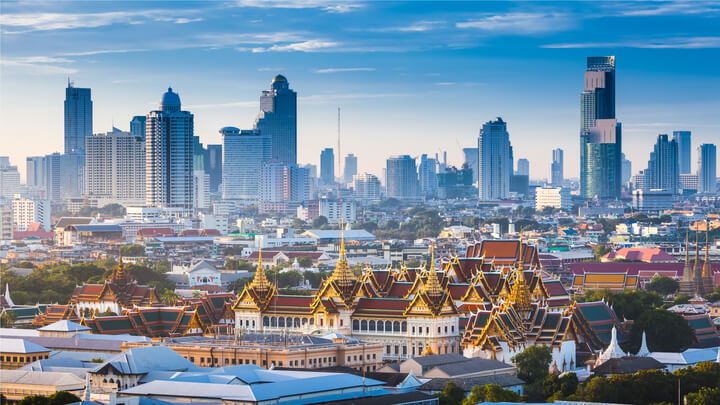Money and currency in Thailand
Everything you need to know about what money and banks to use in Thailand.

Are you travelling to Thailand for your dream holiday?
If so, you may be worried about where to get a good deal on Baht (Thai currency). While ATMs are everywhere and will give you the best exchange rate possible, fees are high and can in some cases cost you money.
Thankfully, we’re here to help. Here’s what you need to know about where to find ATMs in Thailand and how to avoid paying too much to use them.
ATMs are extremely common in most major cities and towns. You’ll find them at bank branches, on street corners, at major stores such as Tesco Lotus and 7-Eleven and in shopping malls. You’ll also find them in major airports.
The following are five of Thailand’s best-known banks. Click on the bank’s name to visit its online ATM locator:
You might not find ATMs in rural areas and on some of the lesser-known islands. So, if you plan on venturing somewhere off the beaten track, it’s best to withdraw money beforehand.
Thai ATMs work with Cirrus, Maestro, MasterCard and Visa (Plus) cards. Your bank can confirm whether your card belongs to one of these networks. ATMs should display the logos of all networks they work with. You can also find a network ATM near you by using the Visa ATM locator or the MasterCard ATM locator.
Thai ATMs work with chip-and-pin type cards and with cards that have just a magnetic stripe at the back. They also accept both four-digit and six-digit PIN numbers. However, Thai ATM keypads don’t have letters, so you’ll need to remember your PIN numerically.
Also, don’t forget to let your bank know when you’ll be in Thailand. Unless your bank is aware you’re abroad, they might consider your transactions suspicious and freeze your card for security reasons.
Most Thai ATMs have a daily withdrawal limit of ฿20,000 (approximately US$572). One large withdrawal often works out cheaper than several smaller ones, so you should confirm with your bank whether your card can handle this limit. If it doesn’t, try adjusting it accordingly with them.
Additionally, some banks have a slightly larger daily limit. Bangkok Bank’s limit is ฿25,000 (US$715). Bank of Ayudhya (Krungsri Bank), has a daily limit of ฿30,000 (US$858).
ATM withdrawals offer the best deal on the exchange rate, provided you choose to be charged in the local currency - Baht (฿). Withdrawals in Baht are converted using the mid-market rate, the fairest exchange rate possible.
Choose to be charged in your home currency, and the ATM will make up an exchange rate using Dynamic Currency Conversion. This is a bad deal which can cost you money and most ATMs in Thailand are set to automatically offer this option, so be careful. Always press “no”.
Unfortunately, the fees for using an ATM in Thailand are expensive. Most local banks charge ฿200 (approximately US$6) per transaction for withdrawals with a foreign bank card. Aeon Bank charges ฿150 per transaction. At about US$4.30, this is still quite expensive.
Your home bank will also charge fees. Expect to be charged a withdrawal fee and a foreign currency fee per transaction.
There are various ways you can avoid, or at least reduce ATM fees.
Here’s how.
To date, no bank in Thailand is part of the Global ATM Alliance. However, your home bank may still have a correspondent banking relationship with a Thai bank that would allow for free or cheaper ATM fees. So, it definitely doesn’t hurt to ask.
On a related note, Citibank has a number of ATMs around the country. Its customers can use the bank’s worldwide network of ATMs free of charge. So, it’s worth checking if your bank might also have an arrangement with Citibank that allows you to use their Thai ATMs fee-free or at a reduced cost.
While Krungsri Bank charges ฿200 per withdrawal, it has a higher daily withdrawal limit - ฿30000. Use this to your advantage by making one large withdrawal instead of several smaller ones.
Don’t let those large numbers shock you, though. Use an online currency converter to find out how much that is in your local money. In Thailand, the cost of living is quite cheap, even in major cities. ฿30000 should be more than enough to cover your expenses for a whole month.
Aeon Bank’s daily withdrawal limit is ฿20000. However, at ฿150 per transaction, their ATM fee is the cheapest one around.
While not ideal, using a human bank teller avoids the Thai ATM fee completely. There’s also the added benefit of no withdrawal limit, which means you can get as much money as you need in one transaction.
However, your home bank may still charge fees, so it’s best to double check with them before you travel to Thailand.
Some cards may be cheaper to use abroad. If you own more than one card, check your bank’s fee structure to find out which one has the most favorable terms.
It’s usually better to use a debit card rather than a credit card. Credit card companies treat withdrawals as cash advances. They often have higher per transaction fees than debit cards and will also attract interest.
ATM fees for withdrawals made with a Thai bank card are significantly cheaper than those made with a foreign bank card (about ฿10 to ฿20). Because you’re using a local card, you’ll also avoid any foreign transaction fees levied by your home bank.
Some ATMs may offer you a ‘service’ of being charged in your home currency. While you may feel relieved to see the figures on terms you’re more familiar with, it’s always best to decline this option. Being charged in the local currency helps you avoid hidden ATM rip-offs by giving you the best possible exchange rate. Choosing to see the transaction shown in your home currency gives the ATM permission to give you an arbitrary (generally much more unfavorable) exchange rate for your withdraw.
If you or a friend have a Thai bank account, use Wise to send money to Thailand ahead of time and save even more. Not only does Wise use the real mid-market exchange rates (which almost always beats the banks), but because your money is received and sent locally in both your home country and in Thailand, all those nasty international fees magically disappear. Give it a try.
*Please see terms of use and product availability for your region or visit Wise fees and pricing for the most up to date pricing and fee information.
This publication is provided for general information purposes and does not constitute legal, tax or other professional advice from Wise Payments Limited or its subsidiaries and its affiliates, and it is not intended as a substitute for obtaining advice from a financial advisor or any other professional.
We make no representations, warranties or guarantees, whether expressed or implied, that the content in the publication is accurate, complete or up to date.

Everything you need to know about what money and banks to use in Thailand.

Thailand is a hotbed for tourists from abroad. If you’re traveling from the US, Britain, or Australia, there are usually no compulsory vaccinations required...